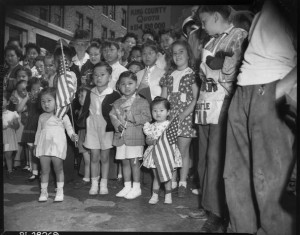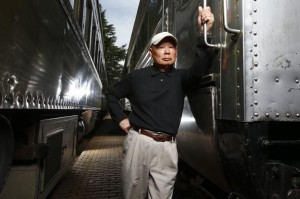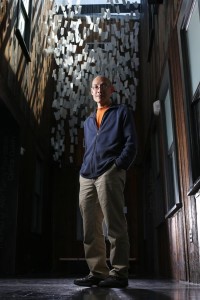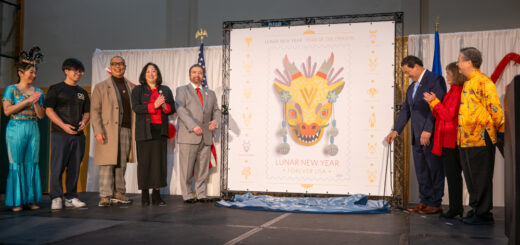Next generations tell the buried tales of Chinese Northwesterners
The backbreaking struggle of the Northwest’s first Chinese comes to light.
By Ron Judd
Pacific NW staff writer
Source: The Seattle Times
 THE KEEPERS of the story can point to pieces of it lying, half-buried, all around us.
THE KEEPERS of the story can point to pieces of it lying, half-buried, all around us.
A granite marker near a shoreline in Bellingham declares: “Chinese Deadline: No Chinese beyond this point, 1898 — 1903.” It’s a line of demarcation preventing — under threat of death — workers at the world’s largest salmon cannery from mingling with white townsfolk in Fairhaven.
Long-forgotten King County court records document the murder of three Chinese laborers, shot while sleeping in tents Sept. 5, 1885, in what is now suburban-chic Issaquah — their alleged white killers all eventually exonerated.
Another granite marker — this one placed by Chinese, white and native volunteers in 2011 on a nondescript gravel bar along the Snake River on the Oregon/Idaho border — marks the ruthless 1887 slaughter of as many as 34 Chinese gold miners. The killers, local horse thieves, were identified but never brought to justice.
And newspaper archives detail the events of Feb. 7, 1886, when Seattle mobs herded the city’s 350 Chinese residents to the foot of Main Street to a waiting steamship — part of a wave of expulsions that swept through Port Townsend, Tacoma and across the Northwest.
Sewn together as a narrative, the pieces tell a tragic tale that ultimately turns triumphant for the children and grandchildren of these Chinese immigrants. Yet even today, the sometimes-violent racism they encountered for nearly a century is rarely discussed in polite circles, perhaps out of deference to the remarkably rapid integration of the Northwest’s thriving modern Chinese community.
In little more than a century, after all, Chinese Northwesterners morphed from an oft-despised labor force to a valued segment of an increasingly diverse community. Nobody today denies the history. But outside of ethnic-studies groups, it’s not common Northwest dinner-table conversation, either.
The question looms: Has the Northwest ever fully come to terms with its Chinese-immigrant past?
 “No, because people don’t know about it,” says Doug Chin, a retired city of Seattle and Washington state employee whose recent book, “Chinese in Washington State,” co-authored with his brother, Art, is as close as there is to a definitive history.
“No, because people don’t know about it,” says Doug Chin, a retired city of Seattle and Washington state employee whose recent book, “Chinese in Washington State,” co-authored with his brother, Art, is as close as there is to a definitive history.
But thanks to new archaeological work, trends in historical study and especially the resolve of some aging Seattle Chinese-American history buffs — the first of their families born in the U.S. — cracks are forming in the don’t-go-there facade long masking local Chinese history.
The remarkable role their ancestors played in opening the West, some of these Chinese-Americans say, can’t be fully appreciated without swallowing hard and reconciling the ugliness that long lived alongside it. And that understanding must extend to younger Chinese-Americans as well as recent immigrants.
“Our generation paid the price,” says Bettie Luke, sister of the late Seattle City Councilman Wing Luke, for whom Seattle’s Asian-American museum was named. “Newcomers need to know whose shoulders they’re standing on.”
 TODAY, IN what generally is regarded as liberal, culturally accommodating Western Washington, it would be difficult to imagine life without a thriving Chinese influence. In short order, by historical standards, the local Chinese-American community became ingrained in the larger social fabric; some members emerged as civic leaders. The most prominent, former Gov. Gary Locke, is the U.S. ambassador to China.
TODAY, IN what generally is regarded as liberal, culturally accommodating Western Washington, it would be difficult to imagine life without a thriving Chinese influence. In short order, by historical standards, the local Chinese-American community became ingrained in the larger social fabric; some members emerged as civic leaders. The most prominent, former Gov. Gary Locke, is the U.S. ambassador to China.
But it is equally difficult to imagine what those who came before them endured to get here and stay.
The first Chinese arrived in the Northwest with the 1789 John Meares expedition; a few Chinese settlers arrived in Seattle in the 1860s. But a decade before that, Chinese laborers, pursuing the California gold-rush legend of Gim San, or “Gold Mountain,” had fanned out in the West, filling a need for hard laborers.
In the Northwest, these immigrants, most fleeing poverty, famine and war in southern China, worked backbreaking jobs in mining, agriculture, canneries, fishing and lumber milling. Chinese laborers built the most treacherous stretches of the Northern Pacific Railroad and other rail lines. They dug the Lake Washington Ship Canal and cleared the way for Seattle roads.
Appreciation for their work is mostly lost, or simply was not documented, because of the racial strife it provoked as local labor groups began to react violently to imported workers willing to work for half the going rate.
But as archaeologists keep unearthing evidence of rural Chinese settlements — and some untimely deaths — across the Northwest, often on lands controlled by the U.S. Forest Service or National Park Service, they are finally documenting, for the first time, the “continued presence” of Chinese across the region.
Even so, accurate historical records are hard to come by.
Unique to Chinese immigration is the widespread occurrence of “paper sons” and “paper daughters” who gained entrance to the country by fabricating — often with the assistance of sympathetic local white residents — a life history to skirt the Chinese Exclusion Act that began in 1882 and remained in place, buttressed by additional legislation, until repeal via the Magnuson Act of 1943. The Exclusion Act was the first immigration measure in the nation’s history to discriminate against a specific ethnic group.
As a result, researchers combing through Chinese immigration records often find it impossible to separate truth from fiction. Some of those “paper” family secrets went to the graves of a previous generation. Others are held by aging immigrants still fearful of bringing shame on their families.
 Chinese community leader Ron Chew, the Wing Luke Museum’s first director, says his grandfather came to Seattle in 1911 after manufacturing a history indicating he was born on Occidental Street long before the Exclusion Act. A cannery worker, he settled in Chinatown — his fictional place of birth. But the exclusion laws kept his wife in China for decades. Chew’s grandfather returned to China long enough to father children, the sons also later emigrating to the U.S. and adopting the same pattern.
Chinese community leader Ron Chew, the Wing Luke Museum’s first director, says his grandfather came to Seattle in 1911 after manufacturing a history indicating he was born on Occidental Street long before the Exclusion Act. A cannery worker, he settled in Chinatown — his fictional place of birth. But the exclusion laws kept his wife in China for decades. Chew’s grandfather returned to China long enough to father children, the sons also later emigrating to the U.S. and adopting the same pattern.
That’s how Chinese were able to maintain a presence in the U.S., even while it was illegal to immigrate, says Chew, who was born in Seattle in 1953 as a full-fledged citizen. “But nobody wanted to talk about it.”
Some still don’t, and the stigma of that disconnect lives on.
Some of the reluctance to go there is obvious, Chew notes: “People don’t like to revisit ugliness.” Language is also a barrier. Many younger Chinese-Americans don’t speak their grandparents’ dialect.
And, like many Chinese-Americans, Chew struggled as a young man with a racial and social identity plagued by missing parts.
“These families are kind of split,” Chew says. “Your history and your memory and your identity are lost in this cross-Pacific divide. It still affects me because a piece of me is in both places.”
FOR SOME keepers of the Northwest Chinese story, bridging that gap has been a life’s mission, born of their own serendipitous ethnic self-discovery during the country’s Civil Rights era five decades ago.
As a Chinese man growing up in Seattle in the 1950s, “I never heard anything about this,” says Doug Chin, who was enlightened to the difficult plight of his ancestors by a graduate-school paper written by his brother in the 1960s. Doug Chin started his own research in 1971, hoping to foster a sense of pride in the achievements of his forebears.
Often, pride in their ancestors’ stories gets lost in a more powerful emotion — shame — says Ben Bronson, a Bainbridge Island historian who has chronicled the plight of Northwest Asians on a website for the Chinese in North America Research Committee. “This is very recent history,” he says. “We’re talking about people’s grandparents, great-grandparents at most.”
There’s also a stigma attached to focusing a spotlight on ancestors viewed as lower-class, uneducated people, Bronson says.
He and other academics have made progress using a “transnational” lens to take fresh looks at this history. The Northwest Chinese story, which pulls together events in the U.S., Canada and China during a unique period of U.S. expansion, fits the bill. A recent historical account by Rutgers University history professor Kornel Chang, now used as a text in graduate history programs, details Washington state’s long-running civic love/hate relationship with Chinese immigrants, mostly in the interest of commerce. Trade-hungry Seattle fathers — people named Suzzallo, Burke, Pigott and Ballinger — formed the Seattle China Club in 1916 to fight exclusion laws even as blue-collar citizens were rousting Chinese workers from their homes. (Tellingly, local capitalists always seemed to find a way to bring Chinese workers to job sites, even when the federal government forbade it. Seattleites who pushed the Chinese out of town in 1886 abided the return of many to help rebuild after the Great Seattle Fire of 1889.)
To Chin, any new attention is good. But he’s still wary of outsiders becoming keepers of the story. Some of those outsiders, ironically, are also Chinese immigrants — newcomers who arrived after the Immigration Act of 1965 reversed the still-restrictive Magnuson Act immigration limits and opened the gates for large numbers of Chinese to legally enter the country.
Most of these “new” Chinese residents work in higher-paying tech fields and live in their own communities on the Eastside, and seem to exhibit little interest in sacrifices made by their local Chinese counterparts, Chin says.
“I don’t think they respect the struggles that we went through.”
 Connie So, who teaches American Ethnic Studies at the University of Washington, isn’t so sure. A healthy share of students in her classes are recent immigrants from mainland China, says So, whose family emigrated from Hong Kong to Seattle in 1969, when she was 4.
Connie So, who teaches American Ethnic Studies at the University of Washington, isn’t so sure. A healthy share of students in her classes are recent immigrants from mainland China, says So, whose family emigrated from Hong Kong to Seattle in 1969, when she was 4.
She believes a larger impediment to sharing the story is a precipitous drop in understanding history among young people of all ethnicities in the current short-attention-span digital era.
“They think, ‘That’s in the past, so I don’t care about it,’ ” she says. To a frightening degree, “Our emphasis on history is gone.”
ALL OF THAT amounts to an uphill battle for the keepers of the story, who fear no one will take up the task when they’re gone. To prevent that, some are working outside the box.
One inventive strategy to put young Northwest Asians in touch with their roots was crafted by David H.T. Wong, a Vancouver, B.C., architect whose personal project to pass the region’s Chinese history to his own children ballooned into a 240-page graphic novel, “Escape to Gold Mountain.”
The book puts the struggles of his ancestors in a hip, accessible, comic-book format that’s chock full of historical details. It opens with young Canadians visiting a museum and recoiling over the name of a fish-processing machine, the “Iron Chink” (a specimen of which is displayed at Seattle’s Museum of History & Industry), as an entree into the region’s racially charged history.
The book’s message is sometimes stark, but it’s ultimately one of hope and reconciliation, not a demand for apologies or reparations, Wong says.
That theme is echoed by Bettie Luke, whose strategy to get modern Northwesterners to confront the story is to put even more pieces of it out in plain sight. The museum bearing her brother’s name recently won affiliation with the National Park Service. Bettie Luke also has been instrumental in projects such as the monument marking the site of the Snake River massacre, and now has set her sights closer to home.
Luke, Chin, Chew and others are in discussions with the city of Seattle to place a fitting memorial to its Chinese immigrants on the revamped waterfront — somewhere near the spot where they were so rudely banished from the continent in 1886. The idea sprung up two years ago, when members of the Seattle Chinese community decided to march from the International District to waterfront docks to commemorate the event.
Luke suggested a slight twist.
“I organized a reverse march, where we met at the docks and came into Chinatown,” she says. “I want more of that message created. It isn’t to point fingers and create guilt. It’s like, ‘Hey! Learn from this and don’t ever let it happen again.’ ”
A monument might seem a token, but it would be an important one, Chew believes.
“When you’re able to embrace your history, both the good and bad, then you’re able to turn a fresh page and begin on a lot more equitable ground.”
Other communities already have done so. That curious “Chinese deadline” marker in Bellingham, for example, placed by a historian simply hoping to provoke conversation, was dug up and replaced two years ago.
 A new plaque at the same site has added wording to the original message: “Mayor apologizes to Chinese community, 2011.” And surrounding the English words are Chinese characters bearing a message from Confucius, who might have been speaking for the story keepers themselves.
A new plaque at the same site has added wording to the original message: “Mayor apologizes to Chinese community, 2011.” And surrounding the English words are Chinese characters bearing a message from Confucius, who might have been speaking for the story keepers themselves.
Roughly translated: “Study the past if you would know the future.”
Ron Judd is a Pacific NW magazine staff writer. John Lok is a Seattle Times staff photographer.






